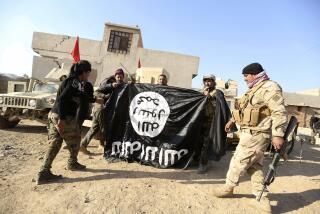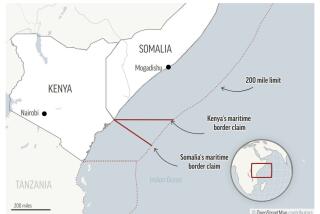Special Ops No Model for Military
- Share via
SOUTH POMFRET, Vt. — A team of Navy SEALs slithers ashore from a waiting submarine, but it is not alone.
Friendly robots search for mines and other obstacles in the waters off the beach. On shore, unattended ground sensors detect and report sounds and movements up ahead. Overhead, unmanned flying vehicles conduct aerial surveillance.
The special operators move inland, connected to the sensors and their mother ship by laptop computers with a wireless network. At their target, they place remotely controlled digital cameras and chemical-agent detectors cleverly camouflaged to blend into the surroundings. The SEALs also take soil samples, then silently withdraw.
Back on the submarine, technicians analyze the samples, and intelligence specialists evaluate data from the myriad sensors. They identify the location as a covert terrorist laboratory for weapons of mass destruction. The secretary of Defense orders an immediate missile attack. The emplaced sensors and cameras report back the results. Mission accomplished.
This is no Hollywood script. It was a military exercise conducted in January at Great Stirrup Cay in the Bahamas.
When Secretary of Defense Donald H. Rumsfeld speaks of his agenda for the war on terrorism and military “transformation,” what is uppermost in his mind are futuristic rock ‘em, sock ‘em experiments such as January’s “Giant Shadow.” It is a seductive vision.
Both the Taliban and Saddam Hussein were toppled quickly by campaigns that relied heavily on U.S. special operations -- supported by unprecedented intelligence, amazing air power and the best gadgets money could buy. Now, special operators, with their clandestine ease and instant-response capability, are the centerpiece of the Bush administration’s war on terrorism throughout the world.
Yet the impeding two-year anniversary of the Sept. 11 attacks in New York and the Washington area finds us with that war far from finished. Iraq is in turmoil, with more Americans killed since the Pentagon declared major combat operations over than died during the war. The Taliban is reconstituting in Afghanistan and Pakistan. Al Qaeda and other terrorist organizations remain potent and threatening.
Sure, the post-9/11 wars have had their successes, and special operators have performed well. But the question must be asked: Is there something about the special operations man-to-man, blow-it-up strategy that leaves us where we are today?
Everyone knows about the amazing rout of the Taliban and Al Qaeda in Afghanistan: A few hundred special operators working with local warlords did what hundreds of thousands of Soviet soldiers could not do.
But many also remember Tora Bora, the mountain battle on the Pakistani border. Osama bin Laden was supposedly trapped; somehow, he got away, along with many of his senior aides. The rest is history.
“They just moved,” says retired Army Gen. Montgomery C. Meigs, former European and Bosnia task force commander and now a professor at the University of Texas in Austin. Thousands of U.S. troops and special operators remain in and around Afghanistan, picking off guerrillas and suspected terrorists when they can find them. But all the while, terrorism grows outside of their area of control. So does opposition to the government the United States established in Kabul.
This is the problem with a special operations strategy that, by definition, relies on small numbers. These forces can move quickly, blow things up, bolster and protect friendly forces. But they cannot cover all of the avenues of escape or occupy territory. And they cannot establish popular support when they are here one day and gone tomorrow.
What was the biggest complaint about Operation Iraqi Freedom, as the combat phase of U.S. intervention in Iraq was called? It was that the United States was not deploying enough troops. After Baghdad fell in just three weeks, most of the complaints about the war plan subsided. But the peace plan is a shambles: There are not sufficient troops on the ground to maintain security. Nor is there a basic strategy beyond the “raid over the beach” approach.
Is a special operations bias partially responsible for the state of affairs in Iraq? President Bush changed the entire Iraq war plan to attack a compound in Baghdad on March 19 based on “actionable intelligence” and special operations. Did the tipping of the U.S. hand allow Hussein and his deck of cards to find safety and ride out the attack?
North and west of Baghdad, special operators pinned down Iraqi forces and conducted a fanciful search for weapons of mass destruction. But those few thousand special forces soldiers did not actually meet Hussein’s loyalists and defeat them. Nor were the special forces numerous enough to seal the back doors of the capital city as the heavy conventional American forces came up from the south. Like Bin Laden in Afghanistan, Hussein and company just moved.
Is it only coincidental that in southern Iraq -- where the Iraqi army was thoroughly destroyed and the U.S. and British armies became occupiers in a classic sense after total defeat of the enemy -- the level of postwar deaths has been far lower than in the central and northern sectors of the country? Are Iraq’s borders so porous and is Baghdad so lethal because Iraqi opponents chose to emulate their Taliban and Al Qaeda brethren and fade away rather than fight toe to toe with America’s super-warriors?
The answers to these questions are far from clear. What is clear is that the Pentagon is not addressing them in an objective manner. That is because at the top of the Defense Department there is a love affair with the clandestine, with the easy-to-employ force of lethal special operators and their brethren in covert intelligence. So much so that Rumsfeld insiders have begun to speak of “SOC-izing” the force, that is, transforming conventional forces to be more like those of Special Operations Command.
Retired Adm. Arthur Cebrowski, Rumsfeld’s director of transformation, told an audience at the Heritage Foundation in May that the capabilities of special operators “are all very, very powerful attributes that the entire force should possess.”
“The general rule is that small forces with a depth of local knowledge have more power than very large formations that come from [elsewhere],” he said at another recent presentation.
Though special operators are known for their regional focus, language skills and maturity, the community is actually divided between “raids, rescue and Rambo” types, that is, those focused on “kinetic kill and direct action,” and the “softer” types, who focus on psychological warfare, civil affairs and building popular support.
A retired Air Force special operator and counter-terrorism expert, Col. Wray R. Johnson, says the administration, as well as the Special Operations Command, has clearly focused on the direct-action side at the expense of the softer side in the war on terrorism. “I myself side with the softer side of SOF,” Johnson says. “Kill terrorists when and where we find them, but, thinking strategically, we should emphasize ameliorating if not eliminating the conditions that generate support for the bad guys.”
Retired Gen. Wayne Downing, the former commander of all special operations, agrees: “We’re knocking them off and interdicting operations, but every day another 10, 15, 20 recruits are coming into the training camps.”
Critics of the administration hold that the mere presence of American forces in Iraq is an irritant that feeds terrorism. But the opposite may be true: In reality, fanaticism may flourish where there is too little contact with U.S. forces. In a full-scale occupation, the people cannot help learning the true character of our army. And in this case, whatever other feelings or forces may be at work, where the presence is strong, people cannot fail to see that soldiers are working to make things better -- feeding people, tending the sick and wounded, trying to build and protect local institutions.
Ironically, one of the basic tenets of Rumsfeld’s cherished special operations, and the basis of successful guerrilla warfare, is to build an authentic relationship with the people.
As more and more questions arise about the situation in Iraq, many are pushing an “occupation light” based on special operations. If such a force was centered on the “softer” side of civil affairs and not on the covert hunt, it might make sense. But for now, the Pentagon leadership remains blinkered when it comes to fighting the war on terrorism.
It is lost in its own “Giant Shadow.”
More to Read
Sign up for Essential California
The most important California stories and recommendations in your inbox every morning.
You may occasionally receive promotional content from the Los Angeles Times.










